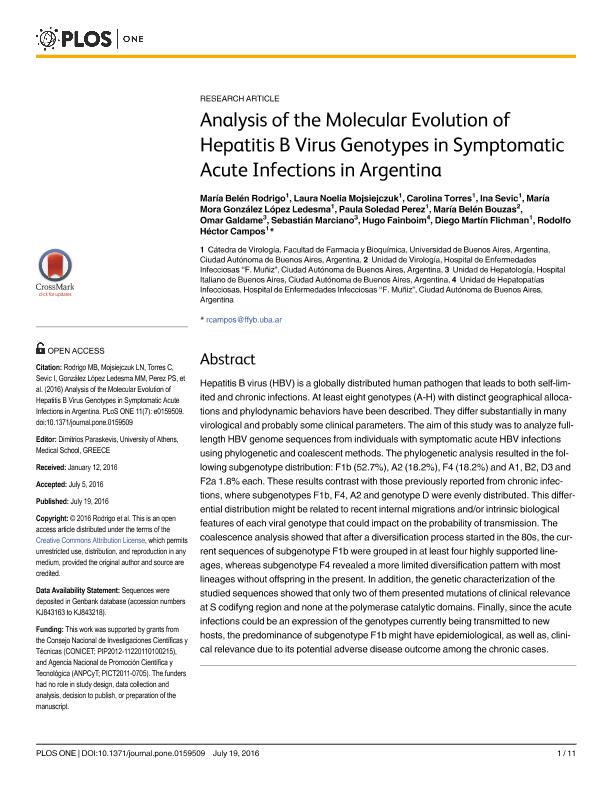Mostrar el registro sencillo del ítem
dc.contributor.author
Rodrigo, Maria Belen

dc.contributor.author
Mojsiejczuk, Laura Noelia

dc.contributor.author
Torres, Carolina

dc.contributor.author
Sevic, Ina

dc.contributor.author
González López Ledesma, María Mora

dc.contributor.author
Pérez, Paula Soledad

dc.contributor.author
Bouzas, María Belén
dc.contributor.author
Galdame, Omar

dc.contributor.author
Marciano, Sebastián
dc.contributor.author
Fainboim, Hugo

dc.contributor.author
Flichman, Diego Martin

dc.contributor.author
Campos, Rodolfo Hector

dc.date.available
2018-03-20T18:04:05Z
dc.date.issued
2016-07
dc.identifier.citation
Rodrigo, Maria Belen; Mojsiejczuk, Laura Noelia; Torres, Carolina; Sevic, Ina; González López Ledesma, María Mora; et al.; Analysis of the molecular evolution of hepatitis B virus genotypes in symptomatic acute infections in Argentina; Public Library of Science; Plos One; 11; 7; 7-2016; 1-11; e0159509
dc.identifier.uri
http://hdl.handle.net/11336/39378
dc.description.abstract
Hepatitis B virus (HBV) is a globally distributed human pathogen that leads to both self-limited and chronic infections. At least eight genotypes (A-H) with distinct geographical allocations and phylodynamic behaviors have been described. They differ substantially in many virological and probably some clinical parameters. The aim of this study was to analyze full-length HBV genome sequences from individuals with symptomatic acute HBV infections using phylogenetic and coalescent methods. The phylogenetic analysis resulted in the following subgenotype distribution: F1b (52.7%), A2 (18.2%), F4 (18.2%) and A1, B2, D3 and F2a 1.8% each. These results contrast with those previously reported from chronic infections, where subgenotypes F1b, F4, A2 and genotype D were evenly distributed. This differential distribution might be related to recent internal migrations and/or intrinsic biological features of each viral genotype that could impact on the probability of transmission. The coalescence analysis showed that after a diversification process started in the 80s, the current sequences of subgenotype F1b were grouped in at least four highly supported lineages, whereas subgenotype F4 revealed a more limited diversification pattern with most lineages without offspring in the present. In addition, the genetic characterization of the studied sequences showed that only two of them presented mutations of clinical relevance at S codifyng region and none at the polymerase catalytic domains. Finally, since the acute infections could be an expression of the genotypes currently being transmitted to new hosts, the predominance of subgenotype F1b might have epidemiological, as well as, clinical relevance due to its potential adverse disease outcome among the chronic cases.
dc.format
application/pdf
dc.language.iso
eng
dc.publisher
Public Library of Science

dc.rights
info:eu-repo/semantics/openAccess
dc.rights.uri
https://creativecommons.org/licenses/by-nc-sa/2.5/ar/
dc.subject
Hepatitis B Virus Genotypes
dc.subject
Acute Infections
dc.subject.classification
Otras Ciencias Biológicas

dc.subject.classification
Ciencias Biológicas

dc.subject.classification
CIENCIAS NATURALES Y EXACTAS

dc.title
Analysis of the molecular evolution of hepatitis B virus genotypes in symptomatic acute infections in Argentina
dc.type
info:eu-repo/semantics/article
dc.type
info:ar-repo/semantics/artículo
dc.type
info:eu-repo/semantics/publishedVersion
dc.date.updated
2018-03-20T14:35:53Z
dc.identifier.eissn
1932-6203
dc.journal.volume
11
dc.journal.number
7
dc.journal.pagination
1-11; e0159509
dc.journal.pais
Estados Unidos

dc.journal.ciudad
San Francisco
dc.description.fil
Fil: Rodrigo, Maria Belen. Universidad de Buenos Aires. Facultad de Farmacia y Bioquímica; Argentina
dc.description.fil
Fil: Mojsiejczuk, Laura Noelia. Universidad de Buenos Aires. Facultad de Farmacia y Bioquímica; Argentina. Consejo Nacional de Investigaciones Científicas y Técnicas; Argentina
dc.description.fil
Fil: Torres, Carolina. Universidad de Buenos Aires. Facultad de Farmacia y Bioquímica; Argentina. Consejo Nacional de Investigaciones Científicas y Técnicas; Argentina
dc.description.fil
Fil: Sevic, Ina. Universidad de Buenos Aires. Facultad de Farmacia y Bioquímica; Argentina. Consejo Nacional de Investigaciones Científicas y Técnicas; Argentina
dc.description.fil
Fil: González López Ledesma, María Mora. Universidad de Buenos Aires. Facultad de Farmacia y Bioquímica; Argentina. Consejo Nacional de Investigaciones Científicas y Técnicas; Argentina
dc.description.fil
Fil: Pérez, Paula Soledad. Universidad de Buenos Aires. Facultad de Farmacia y Bioquímica; Argentina. Consejo Nacional de Investigaciones Científicas y Técnicas; Argentina
dc.description.fil
Fil: Bouzas, María Belén. Gobierno de la Ciudad de Buenos Aires. Hospital de Infecciosas "Dr. Francisco Javier Muñiz"; Argentina
dc.description.fil
Fil: Galdame, Omar. Hospital Italiano; Argentina
dc.description.fil
Fil: Marciano, Sebastián. Hospital Italiano; Argentina
dc.description.fil
Fil: Fainboim, Hugo. Gobierno de la Ciudad de Buenos Aires. Hospital de Infecciosas ; Argentina
dc.description.fil
Fil: Flichman, Diego Martin. Universidad de Buenos Aires. Facultad de Farmacia y Bioquímica; Argentina. Consejo Nacional de Investigaciones Científicas y Técnicas; Argentina
dc.description.fil
Fil: Campos, Rodolfo Hector. Universidad de Buenos Aires. Facultad de Farmacia y Bioquímica; Argentina. Consejo Nacional de Investigaciones Científicas y Técnicas; Argentina
dc.journal.title
Plos One

dc.relation.alternativeid
info:eu-repo/semantics/altIdentifier/url/http://journals.plos.org/plosone/article?id=10.1371/journal.pone.0159509
dc.relation.alternativeid
info:eu-repo/semantics/altIdentifier/doi/http://dx.doi.org/10.1371/journal.pone.0159509
Archivos asociados
